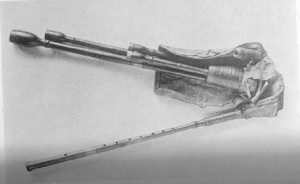Piping History
Despite the close association with all things Scottish, the bagpipes more precisely trace their history through their roots in Asia Minor. References to an instrument similar to the present bagpipes was found on a Hittite stone slab that has been dated 1000 BC! There are also multiple references to the pipes throughout Asia, Egypt and Europe in the first century AD. Theories vary on how the
bagpipes made their way to Scotland with one of the most prevalent being their introduction by Roman soldiers during the time of the vast Roman Empire. It was common for Roman military regiments to have a bagpiper attached.
Whatever the origin, most musical scholars agree on the basic components that define this instrument. There is a bag with a chanter (on which the different notes of a melody is played) and a series of “drones”, or pipes that play a continuous note. Early versions likely had a single drone, with a second and third added over time. The contemporary bagpipe or “Great Pipe” as the Highland version is known has the three pipes and the chanter.
Originally, the bag was made of sheepskin and the pipes of bone, ivory or hardwood. Today, however, many materials are used in the manufacture of bagpipes including leather, rubber and other synthetic materials.

